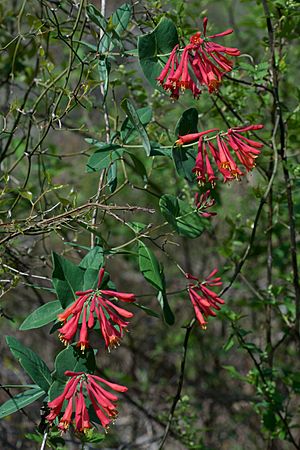Lonicera sempervirens facts for kids
Quick facts for kids Lonicera sempervirens |
|
|---|---|
 |
|
| Conservation status | |
| Scientific classification | |
| Genus: |
Lonicera
|
| Species: |
sempervirens
|
Lonicera sempervirens is a beautiful plant often called coral honeysuckle, trumpet honeysuckle, or scarlet honeysuckle. It is a type of honeysuckle vine that grows naturally in the eastern United States. This plant is well-known for its bright reddish flowers that look like tiny trumpets.
Contents
About Coral Honeysuckle
Coral honeysuckle is easy to spot because of its unique trumpet-shaped flowers. These flowers can be coral, orange, or reddish in color. The leaves and stems of this plant feel a bit waxy. This is a common feature for many plants in the Honeysuckle family.
It grows as a climbing vine, reaching up to 20 feet or more. It can twine its way through bushes and young trees. Its leaves grow in pairs, one across from the other. They are oval-shaped, about 5 cm long and 4 cm wide. The leaves right below the flowers are special. They are joined together around the stem, making a full circle.
When the flowers first appear, they grow in groups at the end of the stems. After the flowers, small red berries grow. These berries are less than 1 cm in size. They appear from summer into fall. It's important to know that these berries are not safe to eat. The leaves stay green for most of the year, making them somewhat evergreen.
The plant's bark is green and soft when it's young. As it gets older, the bark turns a light brown. Older stems might even get a reddish-orange color. The flowers grow in clusters, usually in groups of three. Each flower is about 5 cm long and shaped like a tube. They have five small openings at the tip.
Some special types of coral honeysuckle have been grown for their different flower colors. For example, 'Magnifica' has red flowers on the outside and yellow inside. 'Sulphurea' has yellow flowers, and 'Superba' has bright scarlet red flowers.
Where Does It Grow?
Coral honeysuckle is most common in eastern North America. You can find it as far west as Texas. It grows a lot in the southeastern United States. In Maine, it is listed as an endangered plant. This means it is very rare there and has special legal protection.
Even though it was brought to some parts of New England, scientists have found some coral honeysuckle plants that seem to be growing naturally in Connecticut, Massachusetts, and Rhode Island. It is also considered very rare in Rhode Island. Coral honeysuckle often grows best near the coast.
Naming and Family
The famous Swedish scientist Carl Linnaeus first described Lonicera sempervirens in 1753. He wrote about it in his book called Species Plantarum. There are different types of L. sempervirens. These include Lonicera sempervirens L. var. hirsutula, Lonicera sempervirens L. var. minor, and Lonicera sempervirens L. var. sempervirens. Another name for this plant, which is a synonym, is Phenianthus sempervirens. This plant can also mix with other honeysuckles to create new types, like Lonicera × tellmanniana and Lonicera × heckrottii.
Why Do People Plant It?
Coral honeysuckle is often planted instead of another type called Lonicera japonica. That other honeysuckle is not native and can take over areas. Coral honeysuckle is a great choice for gardens and parks. It is easy to take care of and does not need much attention.
People love to plant it because it attracts hummingbirds and butterflies. These animals help pollinate other plants in the garden. Its bright red flowers also make gardens look very pretty. You often see it growing on fences or special frames called lattices.
You can grow new coral honeysuckle plants in two ways. You can use a piece of a stem (stem cutting) or plant its seeds. In old Native American traditions, this plant was sometimes used to help with asthma and bee stings.
Where It Likes to Live
Coral honeysuckle can grow in many different places. This is because it can handle cold weather well. It likes sunny spots and soil that is a bit wet. However, it can also survive when there isn't much rain.
It can grow in different kinds of soil, like clay or loam. It only needs about 3 to 6 feet of space to spread out. It prefers soil that is a little bit acidic, with a pH of 6. The soil should also drain water well. This plant can grow in full sunlight or in shady areas. It can even live near deer and walnut trees because deer usually don't eat it.
Animals and Coral Honeysuckle
Many animals use coral honeysuckle for food. Butterflies and hummingbirds especially love its sweet nectar. It also attracts bees, moths, and even songbirds. Birds like quail, purple finch, and American robin eat the red berries.
Ruby-throated hummingbirds and insects help pollinate the bright red to pinkish-red flowers. This happens from mid-spring until fall. The plant is also a host for the caterpillars of spring azures and snowberry clearwing moths. Animals use coral honeysuckle a little bit for shelter. However, the plant's berries and leaves do not provide a lot of nutrition for them.
Gallery







